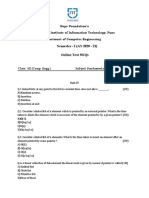0% found this document useful (0 votes)
58 views8 pagesJava Class and Constructor Guide
This document discusses defining a class in Java, including constructors. It defines a class as a template that describes behaviors and states of an entity. A class can contain data members, methods, constructors, and more. There are two types of constructors: default, which takes no parameters, and parameterized, which does. Constructors are used to initialize objects and can be overloaded like methods by having different parameters. The document provides an example program that defines a class with default and parameterized constructors, instantiates objects, and overloads the constructors.
Uploaded by
Raj JoshiCopyright
© © All Rights Reserved
We take content rights seriously. If you suspect this is your content, claim it here.
Available Formats
Download as DOCX, PDF, TXT or read online on Scribd
0% found this document useful (0 votes)
58 views8 pagesJava Class and Constructor Guide
This document discusses defining a class in Java, including constructors. It defines a class as a template that describes behaviors and states of an entity. A class can contain data members, methods, constructors, and more. There are two types of constructors: default, which takes no parameters, and parameterized, which does. Constructors are used to initialize objects and can be overloaded like methods by having different parameters. The document provides an example program that defines a class with default and parameterized constructors, instantiates objects, and overloads the constructors.
Uploaded by
Raj JoshiCopyright
© © All Rights Reserved
We take content rights seriously. If you suspect this is your content, claim it here.
Available Formats
Download as DOCX, PDF, TXT or read online on Scribd
/ 8
































































































